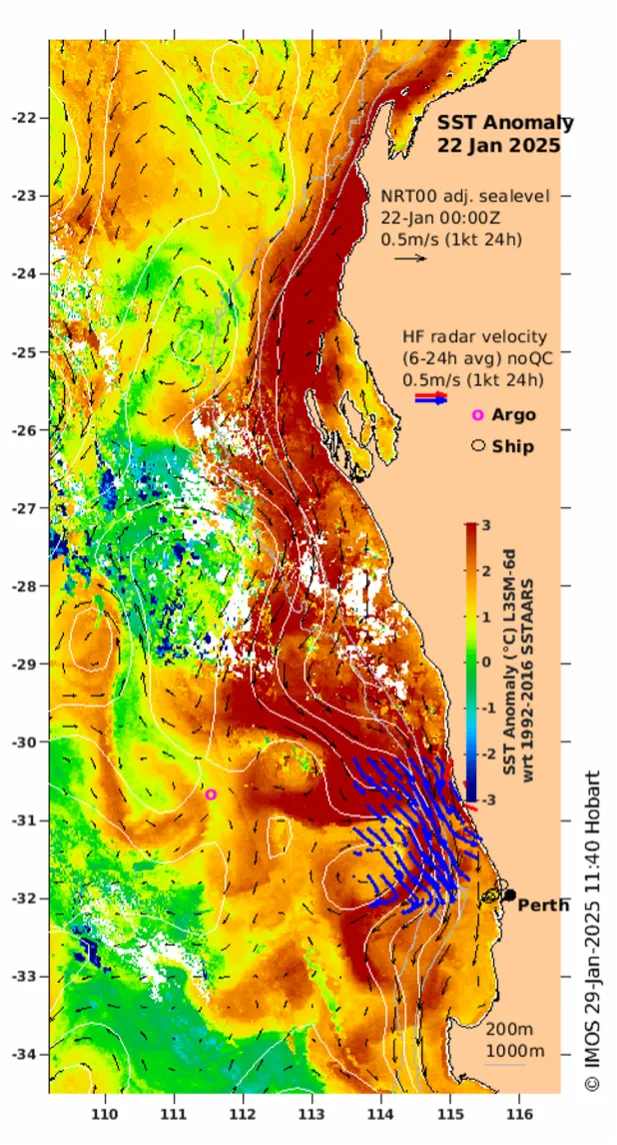Actuarial careers
Industry topics

Claim your CPD points
Sea levels continue to be elevated across Australia. The Southern and South Western Flatlands (West) cluster, which covers Perth and the surrounding area, observed the highest sea level index value ever.
The Bureau of Meteorology has noted that sea surface temperatures were particularly warm off Australia's southern and western coast during the summer. [1]
Across Australia, monthly sea surface temperatures have been the warmest on record for each respective month since October 2024. [2] As seen in previous seasons , warm ocean temperatures lead the water to expand, contributing to higher sea levels.
This marine heatwave off WA was also noted by IMOS OceanCurrent, [3] which observed that the sea surface temperature off the coast of Perth was up to three degrees over the seasonal mean over the summer of 2024/25, as shown below.

Source: Ocean Current. (n.d.). Ocean current news. Retrieved April 24, 2025, from https://oceancurrent.aodn.org.au/news.php
This may have been influenced by the Leeuwin Current, which is a warm ocean current that flows southward along the west coast of Australia. This, in conjunction with strong winds from tropical cyclones such as Tropical Cyclone Sean that existed in the region during the summer of 2024/25, likely transported warm ocean water southward along Western Australia. This would have contributed to the extremely high sea surface temperatures and subsequently high sea levels seen in the south-west.
As well as seeing elevated sea levels, the western parts of the country also experienced high temperatures.
The Bureau of Meteorology noted that Western Australia had its warmest summer on record. [4] Similarly, the extreme high temperature index for western parts of the country showed elevated values.
While elevated extreme high temperature index values were seen across parts of the country, no records were set. This illustrates the difference between high average temperatures and extreme temperatures. Increasing average and extreme temperatures can both have detrimental effects on people and the economy in different ways.
Increases in average temperatures leads to higher energy demands and may lead to additional maintenance costs for infrastructure. It can also reduce crop yields and cause stress in livestock.
Increasing extreme high temperatures can cause sharp increases in mortality, as seen in the European heat wave of 2022 which led to over 62,000 excess deaths. [5] It can also lead to power grid surges, railway malfunction and significant bushfire risk.
From April to July 2025, the Bureau of Meteorology has predicted above average rainfall across much of northern Australia and the eastern coastline, and below average for large parts of the south and west.
The trend towards high temperatures is set to continue. Warmer than average days and nights are deemed very likely across Australia, with an increased chance of unusually high overnight temperatures nationwide. [6]
The Bureau predicts that the El Nino Southern Oscillation system will remain in a neutral state until at least August 2025. [7]
The Index measures the frequency of extreme weather conditions and sea levels across Australia and how these vary over time. Components cover extreme high and low temperatures, extreme rainfall, consecutive dry days, extreme wind and sea level.
The Index was launched in November 2018 by the Actuaries Institute and is updated four times a year by Finity Consulting for the Actuaries Institute.
Unlike many other measures, the AACI focuses on changes in the extremes. This is a more relevant metric for the insurance industry (and others) than averages, as it correlates more closely with damage. This is done by measuring how often we observe the current quarter's observations exceeding the 99th percentile of the corresponding observations in the reference period of 1981-2010. More details and full results can be found on the microsite .
The purpose of the AACI is to provide a publicly available and objective measure of extreme weather conditions and is one way in which the actuarial profession can contribute to the assessment of climate risk.
Alongside the North American Actuaries Climate Index, [8] it is one of two climate indices produced globally on behalf of actuarial associations and has been referenced extensively in the media and other reports. [9]
[1] Bureau of Meteorology. (2025, February 18). ENSO wrap-up archive. http://www.bom.gov.au/climate/enso/wrap-up/archive/20250218.archive.shtml
[2] Bureau of Meteorology. (n.d.). ENSO indices: Weekly Niño3.4. Retrieved April 24, 2025, from http://www.bom.gov.au/climate/enso/?ninoIndex=nino3.4&index=nino34&period=weekly
[3] Ocean Current. (n.d.). Ocean current news. Retrieved April 24, 2025, from https://oceancurrent.aodn.org.au/news.php
[4] Bureau of Meteorology. (n.d.). Seasonal climate summary for Australia. Retrieved April 24, 2025, from http://www.bom.gov.au/climate/current/season/aus/summary.shtml
[5] Ballester, J., Quijal-Zamorano, M., Méndez Turrubiates, R. F., Rodó, X., Lowe, R., & Herrmann, M. A. (2023). Machine learning prediction of dengue outbreaks with non-linear and lagged associations. Nature Medicine. https://www.nature.com/articles/s41591-023-02419-z
[6] Bureau of Meteorology. (n.d.). Climate outlooks. Retrieved April 24, 2025, from http://www.bom.gov.au/climate/ahead/outlooks/
[7] Bureau of Meteorology. (n.d.). ENSO indices: Weekly Niño3.4. Retrieved April 24, 2025, from http://www.bom.gov.au/climate/enso/?ninoIndex=nino3.4&index=nino34&period=weekly
[8] Actuaries Climate Index. (n.d.). Home. Retrieved April 24, 2025, from https://actuariesclimateindex.org/home/
[9] Royal Commission into National Natural Disaster Arrangements. (n.d.). Australian Actuaries Climate Index: Some comments on extremes. Retrieved April 24, 2025, from https://naturaldisaster.royalcommission.gov.au/publications/exhibit-1-006003-shp5010010001-australian-actuaries-climate-index-some-comments-extremes